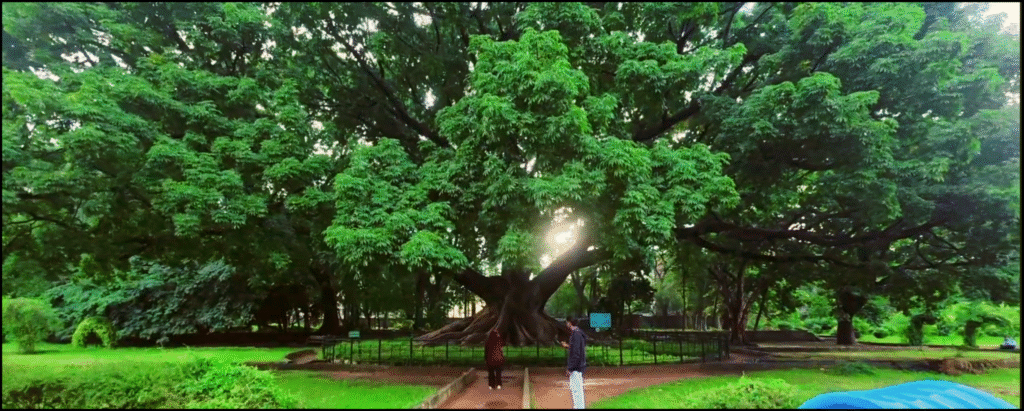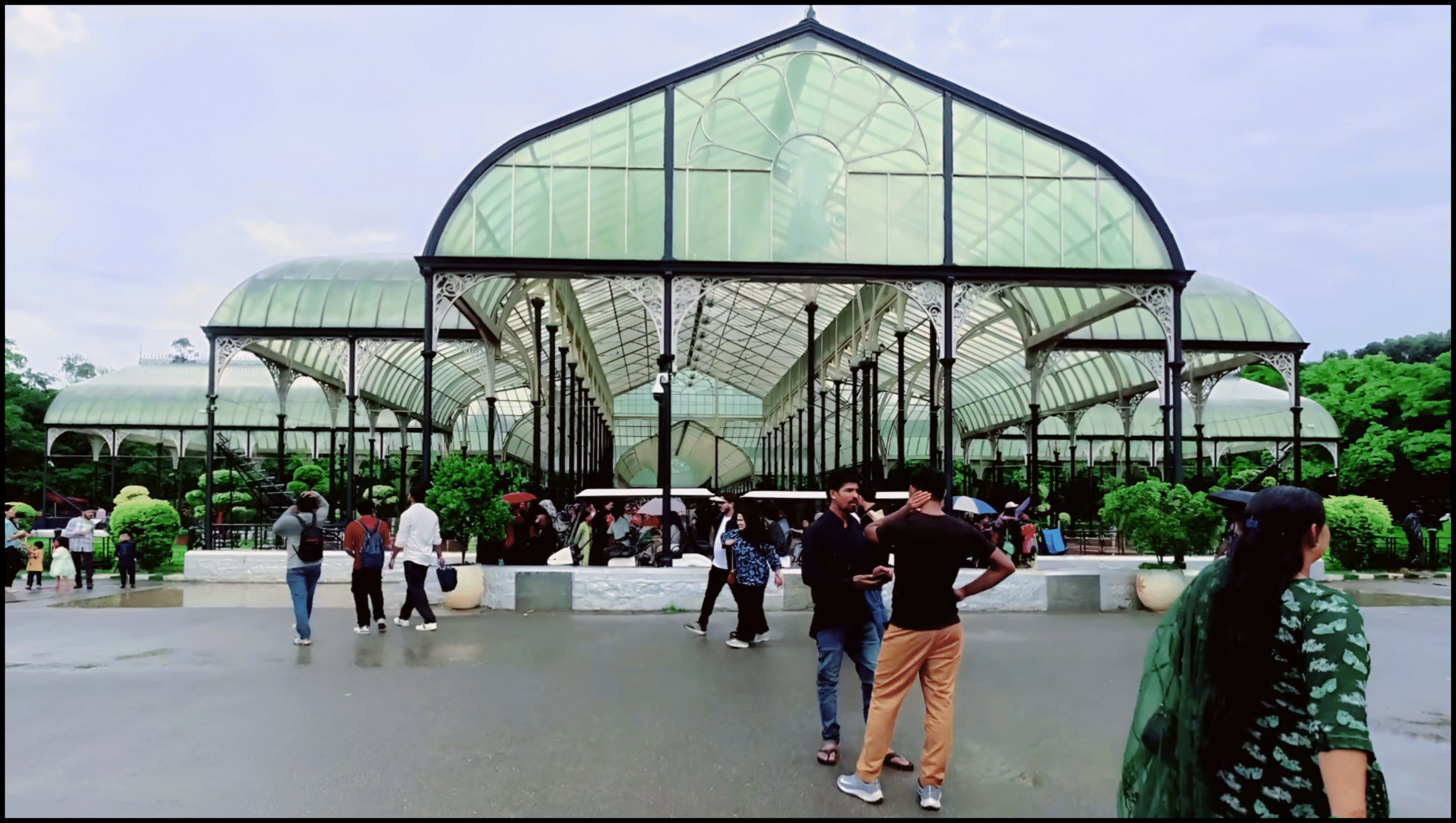A Timeless Icon of Bangalore’s Heritage and Horticulture.
Well this Lal Bagh Glass House is not just a botanical marvel—it’s a symbol of history, heritage, and horticultural excellence. This stunning glass and iron structure, often referred to as the “Crystal Palace of India,” is the centrepiece of the famed Lal Bagh Botanical Garden, which traces its origins back to the 18th century.
The story of Lal Bagh begins under the visionary leadership of King Hyder Ali, who laid the foundation of the garden in the 1760s. Inspired by Mughal gardens and Persian landscaping, he aimed to create a royal retreat full of exotic flora and serene beauty. After Hyder Ali, his son Tipu Sultan, further expanded and enriched the garden, bringing in rare plant species from across the world and transforming it into a world-class botanical conservatory. Today, Lal Bagh stands as a proud testament to their legacy, covering over 240 acres of rich green space in the bustling city.
The Glass House, constructed later during the British era in 1889, was modeled after London’s Crystal Palace. It serves as the venue for the iconic Lal Bagh Flower Show, held twice a year—during Republic Day (January 26th) and Independence Day (August 15th) week. These flower shows are a visual delight, attracting lakhs of visitors who come to witness spectacular floral arrangements, themed exhibits, sculptures made entirely of flowers, and a celebration of India’s diverse plant life.
During these national holiday weeks, Lal Bagh turns into a cultural festival in itself. The garden witnesses such a massive influx of visitors that the total revenue—generated through entry tickets, tent and stall rentals, and food counters—often crosses ₹2.5 crore collectively over the span of the week. It becomes not just a floral exhibition but a lively community space where nature lovers, families, artists, and photographers gather in celebration.
Visitors are advised to plan their visit during weekday mornings if they wish to avoid heavy crowds, especially during the National Days Flower Show weeks when weekends see long queues and packed walkways. The garden is beautifully maintained throughout the year, but there’s an extra charm during these festive weeks when the Glass House is transformed into a floral palace, glittering under natural sunlight and evening lights.
So whether you’re a tourist, a history enthusiast, or a flower lover, Lal Bagh Glass House is a must-visit destination in Bangalore that blends royal history, botanical brilliance, and cultural vibrancy—all under one elegant glass roof.

A Serene Escape in the Heart of Bangalore 🦆🌸🌿
Lalbagh Lake –
Nestled within the iconic Lalbagh Botanical Garden, Lalbagh Lake is more than just a waterbody — it’s a peaceful retreat from the city’s chaos.
This huge lake, almost like a calm pond, mirrors the sky and the lush greenery that surrounds it. 🪷Watch as ducks glide gracefully across the water, adding a gentle rhythm to the scene. Nearby, a charming lotus pond blooms silently, creating a picture-perfect moment for every passerby. And just a little ahead, an artificial waterfall tumbles down rocks, giving you the feel of a mini hillside right inside the city.
On weekends, the lakefront comes alive — families stroll by, friends gather, and photographers hunt for golden-hour magic. Whether you’re here for peace, a picnic, or just to sit and watch life slow down, Lalbagh Lake offers the perfect setting to breathe, reflect, and reconnect.

The Legendary Silk Cotton Tree of Lal Bagh – Standing Tall for Two Centuries–
Tucked away in the sprawling green expanse of Lal Bagh Botanical Garden lies a natural marvel that silently tells the story of Bangalore’s living heritage—the 200-year-old Silk Cotton Tree, also known locally as the Semal tree (Ceiba pentandra).
This ancient giant, with its massive trunk and outstretched, gnarly branches, is believed to be over 200 years old, possibly dating back to the time when Hyder Ali and Tipu Sultan were shaping the garden into a botanical treasure trove. While kings built monuments and palaces, nature built this living monument—rooted in history and stretching toward the sky.
What makes this tree truly stand out is its sheer size and presence. With a broad buttressed trunk that looks like it’s been carved by time itself, and spiny thorns that cover its bark like a suit of armor, the tree commands both respect and awe. Come closer, and you’ll notice its roots weaving in and out of the earth, like ancient veins holding secrets from centuries ago.
During flowering season, this majestic tree bursts into life with soft cotton-like pods that float through the air, giving the surrounding landscape a surreal, dream-like quality. It is both a photographer’s delight and a botanist’s fascination.
More than just a tree, the Silk Cotton Tree is a living archive, having witnessed generations of visitors, gardeners, and naturalists walk past its shade. It has stood tall through the city’s transformation—from royal times to colonial rule, to the bustling IT hub that Bangalore is today.
Today, it’s one of the oldest and most iconic trees in Lal Bagh, often used as a landmark inside the garden. Many nature walks and heritage tours begin or end near this tree, as it symbolizes the endurance of nature in the face of time, change, and urbanization.
If you ever visit Lal Bagh, take a moment to stand beneath its mighty branches, touch its ancient bark, and feel the centuries of silent strength it carries. It’s not just a tree—it’s a witness to Bangalore’s evolving story, rooted deep in the soil of history.


